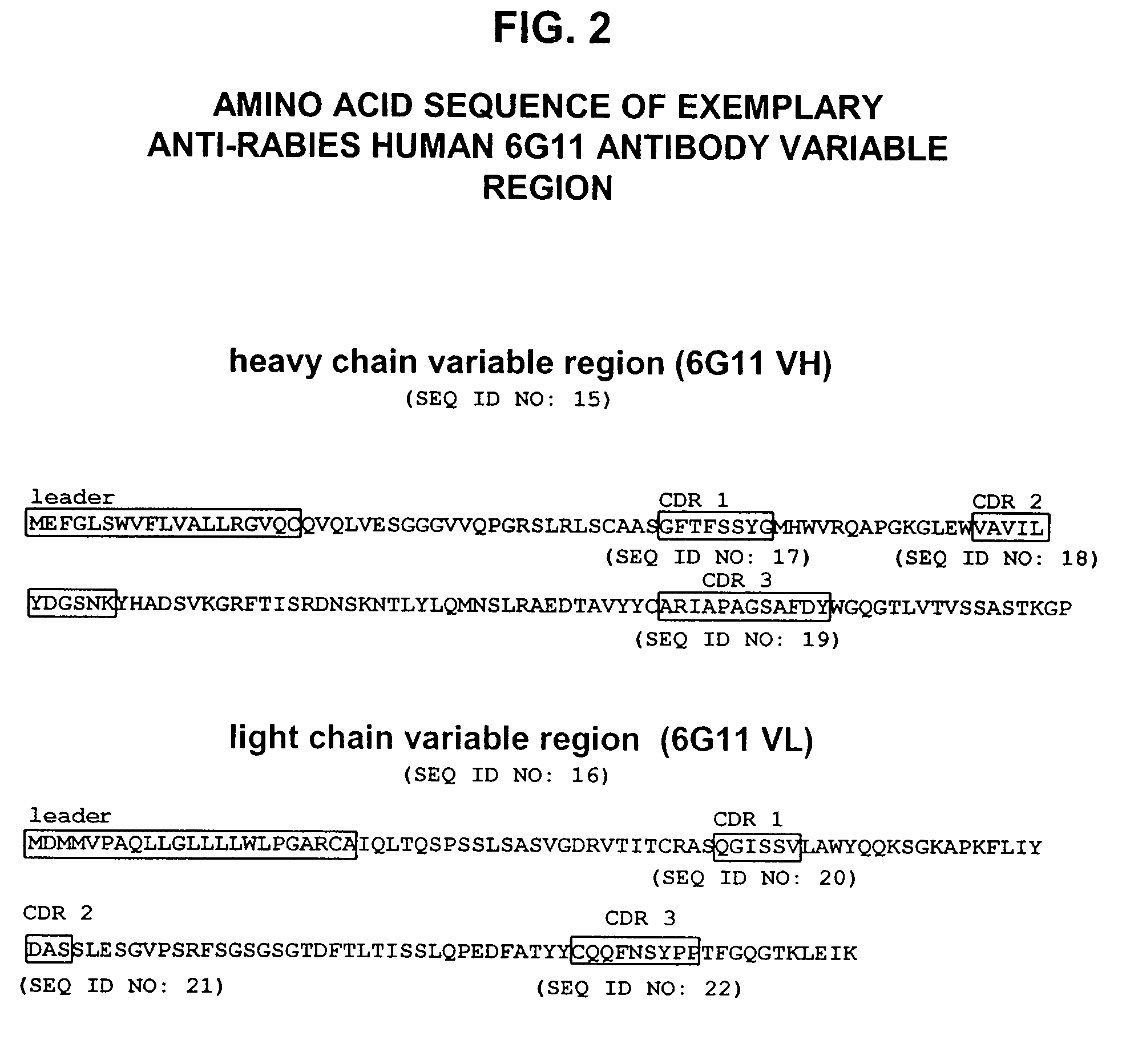Human antibodies against rabies and uses thereof
a technology of human antibodies and rabies, which is applied in the field of human antibodies against rabies, can solve the problems of uncertain obstacles, relatively high cost, and manufacturers of anti-rabies agents, and achieve the effects of less immunogenicity, rapid therapy, and localization to appropriate sites
- Summary
- Abstract
- Description
- Claims
- Application Information
AI Technical Summary
Benefits of technology
Problems solved by technology
Method used
Image
Examples
example 1
Generation of Anti-Rabies Virus Monoclonal Antibodies
[0165]Transgenic mice comprising human immunoglobulin genes generated as described above in the section entitled “Generation of Human Monoclonal Antibodies in HuMAb Mice” and supplied by Medarex, Milpitas, Calif., were immunized with 6 doses of a commercial rabies vaccine. The vaccine was administered in combination with Fruend's complete adjuvant and then boosted with additional rabies vaccine and incomplete Fruend's adjuvant. The rabies vaccine consists of whole rabies virus that has been inactivated and lyophilized. Spleenic B cells were isolated from the immunized animal and fused to mouse myeloma (P3X) cells. Clonal hybridomas were generated and screened by ELISA. Resultant hybridomas were cultured and enzyme linked immunosorbent assay (ELISA) for detection of human kappa / gamma antibody chains was used to detect candidate human IgG antibodies for further analysis. Clones designated 54.17C7; 108.6G11; 35.5G5.1E12.149; 35.2B10....
example 2
Binding Activity of Anti-Rabies Virus Antibodies
[0168]Binding of each antibody to rabies virus, in particular, rabies virus glycoprotein G was determined by ELISA using standard techniques. The affinity of the anti-rabies virus antibodies for rabies virus glycoprotein G can also be measured with a Biacore® instrument, which detects biomolecular binding interactions with surface plasmon resonance technology. Each antibody is added to protein A-coated sensor chips, and rabies virus glycoprotein G is allowed to flow over the chip to measure binding. Binding constants ranging from a KD of 1×10−6M, KD of 1×10−7M, KD of 1×10−8M, KD of 1×10−9M. KD of 1×10−10M. KD of 1×10−11M, KD of 1×10−12M, and higher (or internals or ranges thereof), can be determined. Anti-rabies virus antibodies with favorable binding constants indicate that the antibodies have affinities suitable for use in human therapy.
[0169]The antibody 17C7, when tested on the ectodomain region of a rabies G glycoprotein (codon-op...
example 3
Rabies Virus Neutralization by Anti-Rabies Virus Antibodies
[0170]Antibodies expressed by 17C7, 6G11, 5G5, 2B10, and 1E5 hybridomas were tested for rabies virus neutralization activity in vitro in a series of experiments (see Tables 8-11, below).
[0171]Specifically, rabies neutralizing activity was determined using the Rapid Fluorescent Focus Inhibition Test (RFFIT), which detects rabies virus infection of mouse neuroblastoma cells using fluorescent-labeled antibodies. The RFFIT assay is a standardized assay that is used by medical and public heath experts to determine the potency of a given antibody preparation to neutralize rabies viruses (i.e., inhibit its ability to infect cells). The assay is typically performed using a fixed virus (CVS11) but may also be done using isolates from infected animals. The assay is done by the addition of a standard amount of virus with and without antibody dilutions to monolayers of mouse neuroblastoma cells. The monolayers are incubated then foci of...
PUM
| Property | Measurement | Unit |
|---|---|---|
| temperature | aaaaa | aaaaa |
| concentration | aaaaa | aaaaa |
| concentration | aaaaa | aaaaa |
Abstract
Description
Claims
Application Information
 Login to View More
Login to View More - R&D
- Intellectual Property
- Life Sciences
- Materials
- Tech Scout
- Unparalleled Data Quality
- Higher Quality Content
- 60% Fewer Hallucinations
Browse by: Latest US Patents, China's latest patents, Technical Efficacy Thesaurus, Application Domain, Technology Topic, Popular Technical Reports.
© 2025 PatSnap. All rights reserved.Legal|Privacy policy|Modern Slavery Act Transparency Statement|Sitemap|About US| Contact US: help@patsnap.com



